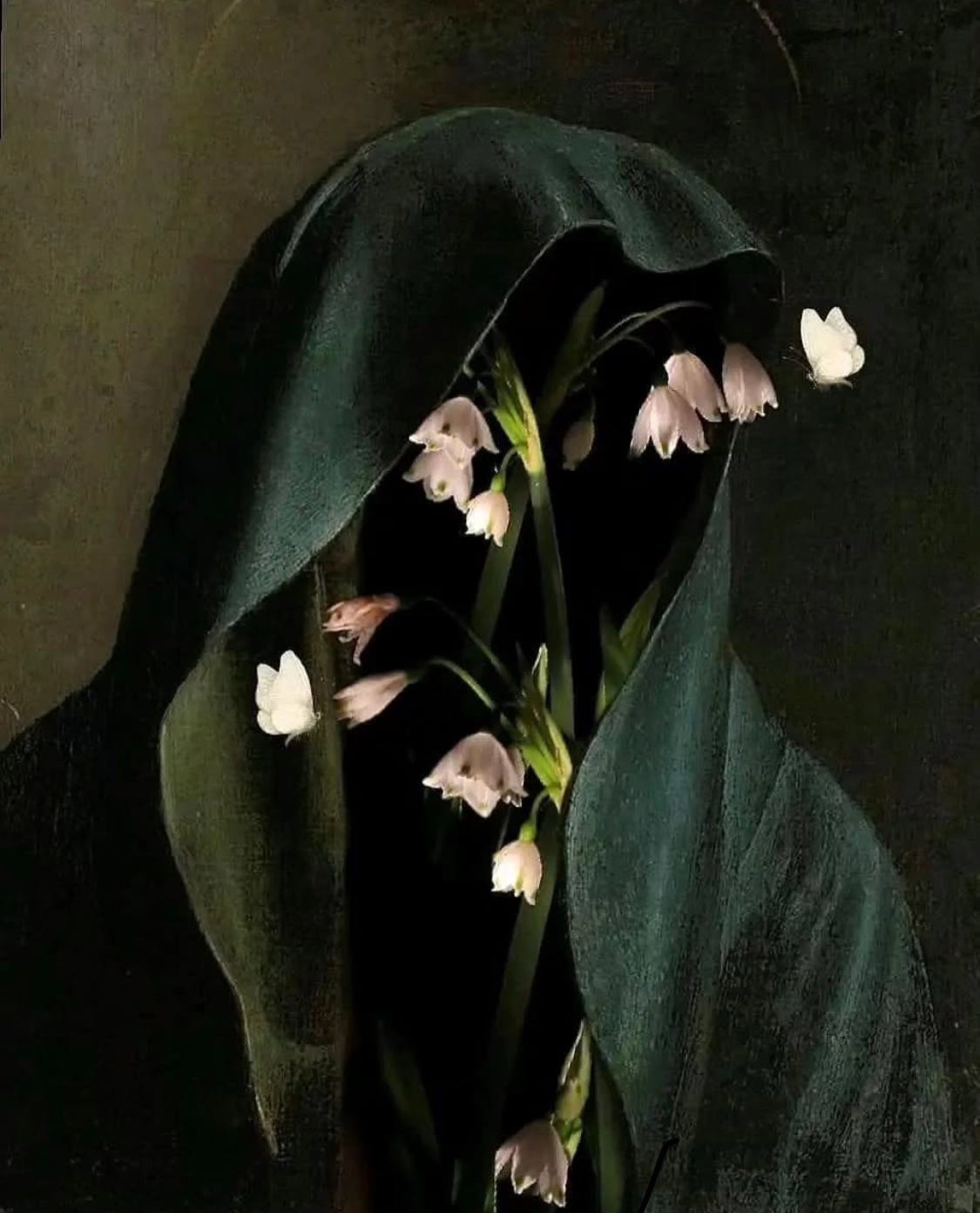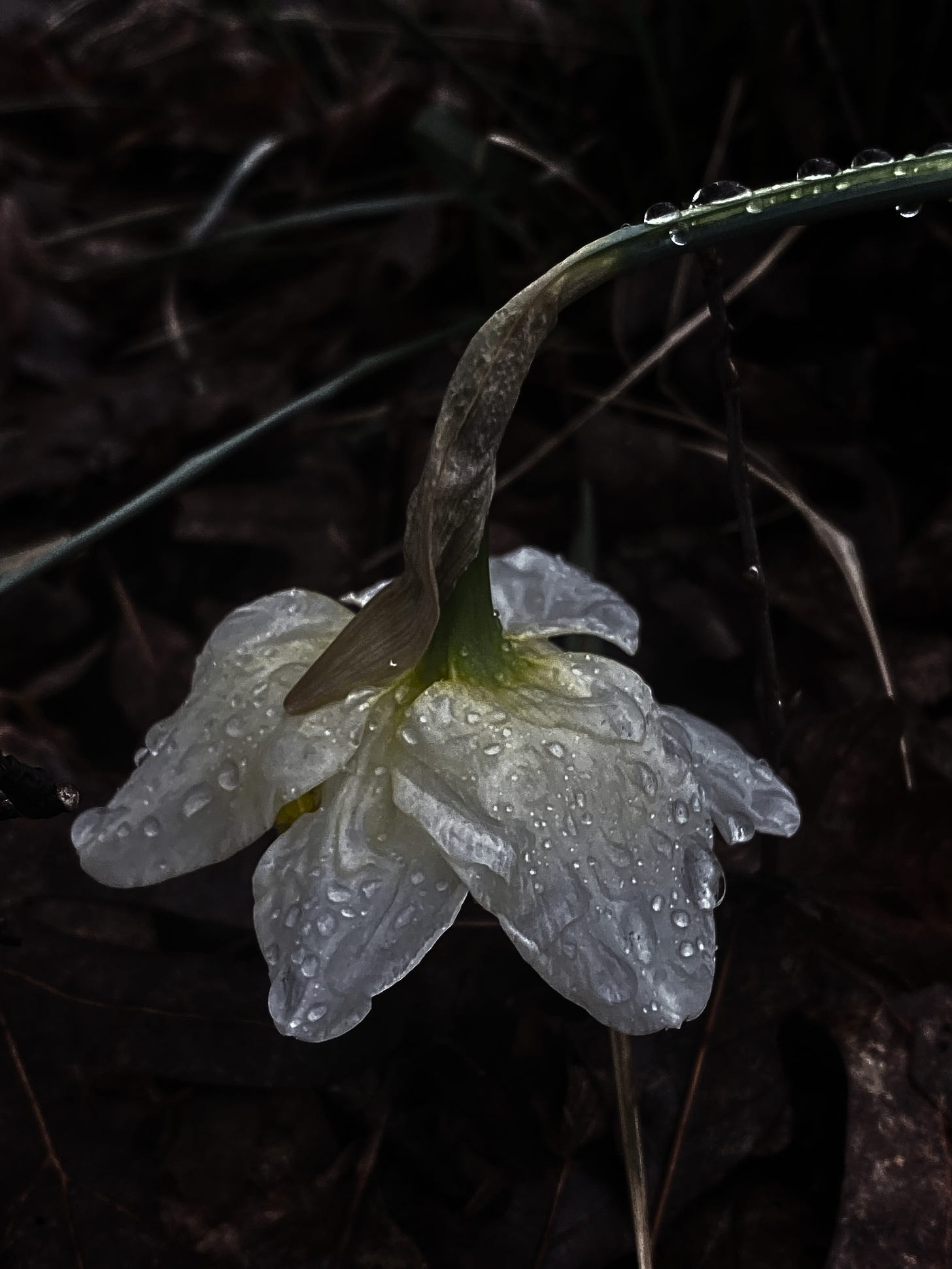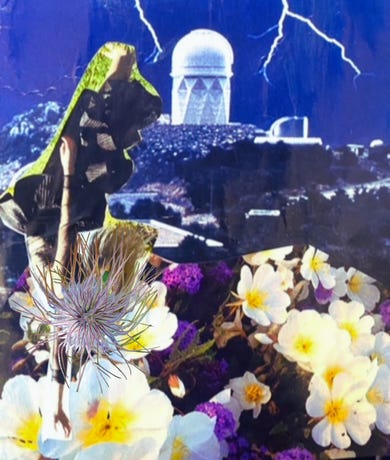A Grief Spell for the Spring Equinox
Restlessness, Cracking Open, and Resurrecting the Sensuous

Dearest Shapeshifters,
As I write this, a flower next to me in the cafe courtyard pokes me in the cheek. It takes several of these pokes for me to actually really turn to them, and smell them.
How is the world calling out to you?
If you live somewhere with Winter, then in Spring, the world around us appears to be doing the impossible as it calls out to all our senses: these first blossoms, these birdsong filled mornings, the sun on the porch, even our own desire, social and creative energies suddenly, sometimes gushingly, returning.
Sometimes.
This year, it’s been overcast and I feel it in my bones. Gravity feels heavier than usual. This is the first Spring since Hurricane Helene. So many trees are gone. So many bodies of water polluted. So much life lost and reminders everywhere. Dragging myself out of bed takes all the energy I can muster, and staying out of bed throughout the day frequently feels impossible. I know I’m not alone.
Amidst Spring’s exuberance, it can be easy to feel like our grief and rage and exhaustion are at odds with the greening world. The contrast of Spring with the horrors of ongoing genocides and rising state violence and ecocide is stark. We want the miracle of springtime for our kin in Gaza and all those whose lives have been taken too soon, or who have been displaced or disappeared. We want the morning birds and the lemon blossoms and the children marveling at the returning green.
What place does our grief have, here, amidst the festive miracle of spring? What place does exuberance have, in these genocidal, police state hellscapes?
I think Spring invites us to remember that joy is always a resurrection.
Alaa Miqdad, a clown of Gaza known as Uncle Aloush, shares:
“Despite the pain, we will find joy. Despite the sadness, we will find joy. I have a lot of pain, but I make the children happy… I tell everyone who wants to make children happy… Support every person you love. Give them hope to live... We will rejoice, sing, live, thrive, and rebuild.”
This equinox, I’m thinking of Spring as the earth’s fiery determination to make life and beauty against all odds. With the arrival of Spring comes the fierce and determined Aries, who reminds us that summoning up and calling back of our power when we’re feeling stagnant or in despair, requires some heat, some fight, and is an active, rather than passive practice. As shares, “You only have power when you exercise it.” (Aries Season Can Give You This…) Persephone’s return from the underworld is no small feat.
And like grief, this fiery energy, remembering our power, comes in waves and cycles. Some days, we won’t be able to access it, but that’s life too (thanks Francis Cimmaron for this reminder). Not everyone blooms at once. The idea that it was ever sustainable to perpetually exert our/the earths' energy and resources without creating space for rest and giving back to that which nourishes is a wild delusion of capitalism that we are composting. Spring invites us to locate ourselves in networks of kin - the only place we will ever survive - trading off our capacity to express and make beauty and fight, to have our time underground, our time of discomfort, tight in the bud, to have our time calling each other back to life, our time making nectar, our time falling apart and feeding the soil below.
Grief as a Bringer of Spring and Joy
Old stories tell us that grief not only has a place in Spring, but that grief BRINGS the Spring. They tell us that Spring is not just soft and stunning, but mighty and fierce, and only arrives through great risk, loss, and interspecies collaboration. As Sophie Strand shares, “becoming new is never safe.”
All around us, brave and brilliant beings are breaking open, and falling apart. Seeds are breaking through soil, making their way up through the cracks, buds and new growth split through stems and bark, tight buds overflow themselves to reveal soft, exuberant faces.
The daffodils in our front yard are heavy with spring rain, bowing their faces and pressing their chests to the soil. Bayo Akomolafe reminds us, “Grieving is how flowers bloom.”
And yet flowers and Spring seem to speak to us of deep joy and play, often mirrored in festive traditions held at the arrival of Spring throughout the world, like the Indian festival of Holi, the Jewish Purim, and the Iranian Nowruz.
If Winter landscapes hold an affirming mirror to our grief and the fertility of stillness and darkness, perhaps Spring reminds us that joy and grief, stillness and movement, risk and nourishment, light and dark, are entangled with one another.
If Winter speaks of honoring natural limits, perhaps Spring speaks of the role of resurgence, of reaching and being with breaking points, and reaching through them, of joy as “the growth of [our] capacity to do and feel new things” (Berman and Montgomery, Joyful Militancy)
If Winter tells us there is a place for rest, then perhaps Spring tells us there is also a place for our restlessness and our “enough is enough”-ness.
Yes, Spring says, things must change.
And the Spring winds say it loudly.
Wind as a Troublemaker of Spring
The other night, I was spooked by the wind howling through the holler as I walked down the puddled, muddy road to my partner’s house. I had the eerie feeling of being watched, and I picked up my pace, eager to get inside.
I’m thinking about winds as the monsters and troublemakers of Spring, and thinking about trouble the way Donna Haraway talks about them:
“Trouble is an interesting word. It derives from a thirteenth-century French verb meaning “to stir up,” “to make cloudy,” “to disturb.” We—all of us on Terra—live in disturbing times, mixed-up times, troubling and turbid times. The task is to become capable, with each other in all of our bumptious kinds, of response...The task is to make kin in lines of inventive connection as a practice of learning to live and die well with each other in a thick present. Our task is to make trouble, to stir up potent response to devastating events, as well as to settle troubled waters and rebuild quiet places.” (Staying with the Trouble)
Like all good monsters and troublemakers, winds shapeshift and unsettle, mix and stir things up, surround us and escape us. Though we can feel and hear and even ride the wind, we cannot contain, hold, or grasp them. They are both highly changeable and move in cycles we can become familiar with. But even when they arrive as expected, like the winds of Spring, they chill us and disrupt our plans, keeping us from getting too comfortable in our eagerness for the ease of warmer days.
And wind, again, like all good trouble, is essential for our ecosystems, carrying moisture, clouds, rain, pollen, spores, nutrients, the countless birds, insects, spiders, and seeds who ride their streams for transportation.
Wind also mixes that which we might hope to contain and isolate “elsewhere”, carrying deadly storms, toxins, pollution, smoke, and fire across empire's desperate borders, walls, and property lines, which I imagine the winds laugh at. They remind us that our worlds and lives have always been permeable and entangled, that “what we do to the mountain, we do to ourselves” (Klee and Princess Benally).
I’m thinking about Rachel Corrie, an American peace activist who was murdered by Israel in Rafah, Gaza on March 16th, 2003, at the age of 23, while blocking a bulldozer from destroying a Palestinian family’s home, a family she had known and stayed with. I’m thinking about how Rachel’s father shared in an interview that he has a strong image of Rachel as a child, twirling in the wind in a field of flowers, and how at 10 years old, Rachel was already making trouble with her refusal to separate herself from what happened to other children around the world, and shared at a children’s press conference in 1989:
“They dream our dreams. We dream theirs. We have got to understand that they are us, we are them.”
Inspiration for Spring Troublemakers: The Wind Flower, The Tower Card, and Precarious Art
I always like to choose some anchors or inspiration for each season. Sometimes they are ideas, sometimes tarot cards, sometimes plants. For this season, I’m choosing The Wind Flower, the Tower tarot card, and Cecilia Vicuña’s practice of Precarious Art.
This Spring Equinox, I’m thinking about the medicine of Anemone, or Pulsatilla, also known as the Wind Flower, who is known to bloom during the earliest, windiest parts of Spring.
Anemone is associated with both fragility and resilience for their endurance of harsh conditions, and is both poison and medicine, reminding us of the old adage, “the dose makes the poison”, and of the power of smallness.
Anemone is one of the most powerful, fast acting, relaxing nervines I have ever worked with, and is especially helpful in the throes and whirlwinds of trauma and acute grief, panic attacks, overwhelming anxiety, and insomnia.
Often said to grow where blood has been spilt in old battlefields in Europe, Anemone is a flower growing out of grief, tears, death, ruins.
In some rural areas in Europe, it is said that fairies would nestle within the Anemone flower for protection, as the flowers close their petals and droop their heads in anticipation of rain and during the night (Grieve).
In Greek mythology, the Anemone springs from the tears of Aphrodite after the notoriously beautiful (and mortal) Adonis was killed by a boar whom he had tried to hunt, against the warning of Aphrodite (Ovid). Aphrodite, who was in love with him, wept and pled for Adonis to live on as a flower, and where her tears landed on the earth, the anemone sprang.
Though mortal in Greek mythology, the story of Adonis comes from a long line of vegetation myths and gods who don't live forever: vegetal gods who cyclically are born and die, who come from and are composted back into the earth, usually through sparagmos, literally being pulled apart in some way: Tammuz, Osiris, Dionysus.
We live in Tower times, precarious times, unraveling times, times in which the world itself seems to be coming apart.
Anemone invites us to soften towards the changes being asked of us, to loosen the tension we hold in our bodies by allowing ourselves to meet and ride waves of grief and change as they come, rather than guarding and bracing ourselves against them. Anemone invites us to stop trying to hold it all on our own, and remember to allow ourselves to be held by others.
In the Dirt Gems oracle deck, Chelsea Granger & Anne Louise Burdett refer to Anemone as “the wind rider”, and share:
“Anemone is a loosener of the often strongly held self-preservation patterns in our thinking; the habits in our body that live in preparation for the next disaster, or the belief that doom is inevitable. Yes, disasters will come some days, but living in a state of hypervigilance will overburden the systems we need in order to survive…”
Together, Anemone and the Tower card in Tarot tell stories about how we meet disaster on the days when it comes.
The Tower tells a story about meeting our limits, losing, failing, cracking, and collapsing as a sacred experience from which life springs. The cards’ image, always evolving, is often depicting something like this: a tower cracked almost clean in half, struck by lightning, in flames, while a figure or two are seen springing or falling from the tower back to the earth.
We can recognize these figures as seeds, as Kim Wayman shared with me, like the Anemone, whose seeds ride the winds and collaborate with the rains to “literally bury themselves”:
"Each seed is attached to an awn that is made up of alternating strands of tissue. Each strand varies in its ability to absorb moisture. As spring rains come and go, the awns will twist and turn with the resulting effect of drilling the seeds directly into the ground." (Matt Candeias).
These seeds (and so much of the green world) are artists in precarity, what these Tower times call us all to be.
Chilean artist Cecilia Vicuña shares:
“What does precariousness consist of? In that everything disappears. That is the core of creation in precarious art. It is an art that is aware of its own disappearance.”
She shares of the origins of her improvisational practice of making Precarios, “works for the sea or traffic to erase”:
“I was still a teenager, and I was on the beach in Chile, and suddenly I felt the wind was alive. And it was sort of caressing me, moving around my body like a snake. And I turned around, and I could see that I was being sensed, as much as I was sensing the world around me. And so in awe, it was like I melted, and I bent down and I picked up one of these precios, a piece of debris right there on the beach, and i touched it, I brought it up, and I planted it in the sand, and that was the beginning of my precarious art. So what is it for me, it is the acknowledgement of the precariousness of life, the precariousness of the beauty of being, and it is an acknowledgement of the fact that we will die. That we are dying as we live..”
Spring invites us to join our ecosystems in their precarious art making as a way of life. The Tower card and anemone teach us about being destroyed by massive change, and allowing ourselves to be moved and changed by the trickstery power of grief. They offer us stories about planting ourselves as seeds, reaching through ourselves and towards life from within ruins, to
“make room… for the spirits of the fault line, the new gods that scream through the cracks with the first musical notes of worlds to come.” (Bayo Akomolafe)
A Spell for Breaking Open: In Praise of New Gods
When the Spring winds blow,
May we ride them back to each other,
Back to the earth,
Back to the ocean,
Back to our fault lines,
Where all possibilities spring.
May we trust that we can’t know
What we are capable of
By only bracing ourselves
and turning away.
May we trust our capacity
To turn towards what’s broken
And as the cracks grow
In who we thought we were
And what we thought was impossible,
May we water them
And allow ourselves to become new.
Yours,
Mara June
Grief Magic 2025-2026 Opens Soon & Begins this April!
Grief Magic is a year long creative cohort exploring themes around grief, magic, creativity, and shapeshifting in tune with the seasons. We’ll be joined by guests like , , and among many others!
Additional themes we’ll be exploring:
Ancestral Stories, Myths, and Timekeeping: Myths, Magic, and Folklore connected to the seasons and grief*
Tarot’s Major Arcana as guides for grief and creative process
Imagination Spells: Envisioning and Practicing Living Futures
Art, imagination, and grief as collaborators and ecological processes
Grief as Time Travel: Exploring constructions and experiences of space and time
Grief, Shapeshifting, De/Constructions of the self: becoming multitudes
The Politics of Enchantment: Mundane Magic, Care, and Enchantment in the Everyday
Entanglement + Collapse: staying with the trouble of love amidst collective + ecological loss
*While I’ll be drawing largely on European myth, folklore, and magic, students are encouraged to explore their own ancestral stories and practices!
A year long creative cohort that meets over zoom. Participants will explore their own processes of shapeshifting, magic, and story-telling, creating and sharing creative writing and art inspired by the themes we explore together. Those in the cohort model will be able to join one another and our guests in seasonal workshops, reflections, discussions of resources and themes, ritual, and creative practice, accompanying one another throughout the year.
Most sessions held Wednesdays, 12-2pm eastern time, recorded for those unable to attend live!
Scholarship Interest Forms Open through 4/3
Full and partial scholarships for low income and BIPOC students are available for the Grief Magic Cohort. Please complete an interest form by 4/3 for this next round of Grief Magic. 💖
Not interested in a cohort but want access to the course materials and guest workshops?
There is also a self paced study version of this course for those not interested in the cohort model! Learn more here.
Subscribe to Grief Spells
Your subscriptions help support my work and help us skirt the whims of the algorithm! As of right now, all subscription tiers (including free) will receive access to seasonal grief spells.
You can also support my writing by becoming a paid subscriber to this newsletter for $16-20/month 💖 Your paid subscriptions help me so that I don't have to spend as much time marketing, and can instead focus on creating and doing what I love. THANK YOU!
Paid subscribers will also get access to live community events each season. These Grief Studios will be spaces to dialogue with, make, and share your own art and writing alongside other grievers. 🕸️







My God, this line: "We want the morning birds and the lemon blossoms and the children marveling at the returning green."
This is a real potent practice, especially now that we all collectively get to grieve in real time the volatile erosion of systems like democracy we hung our values and hopes for the future onto. I will definitely include this in my spring welcoming rites. Thank you for sharing it. ✨🍃🙌🏼